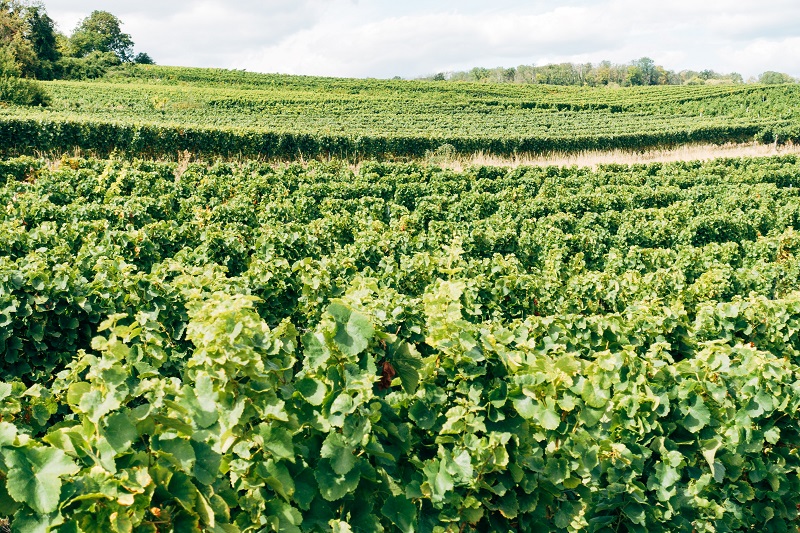Texas Wine Industry Makes Great Strides

Texas is among the top five wine-producing states in the U.S., with an annual economic value of $13.1 billion.
Photo by Tamara Garza
The Texas A&M AgriLife Extension Viticulture and Fruit Lab, organizationally housed within the Department of Horticultural Sciences at Texas A&M College of Agriculture and Life Sciences and operated by personnel within Texas A&M AgriLife Extension Service, has been continuously serving the state’s rapidly growing wine industry since 2007.
Located in Fredericksburg, the laboratory specializes in fruit disease-fighting research and identifying ways to enhance the production value for Texas fruit growers. To date, the facility has played an integral role in helping the Texas Hill Country become a top five wine grape-producing region in the U.S.
“We are one department with one mission — bring our research, teaching, and Extension capabilities in the service of our horticulture industries across Texas,” says Department Head Amit Dhingra, Ph.D. “The Viticulture and Fruit Lab in Fredericksburg is an important part of our mission and has a proven track record of addressing critical issues faced by the industry.”
PIERCE’S DISEASE CONNECTION
The need for the laboratory became evident in early 2000 when many previously unaffected Texas wineries began suffering the effects of Pierce’s disease. This disease can cause large-scale damage to grapevines and significant economic losses to growers. Pierce’s disease threatened the emerging wine industry’s continued growth and long-term success.
“Once we were able to initially get Pierce’s disease under control, we began looking at transitioning into sustainable, long-term management approaches,” says AgriLife Extension Fruit Specialist Jim Kamas. “We began investigating novel pathways to disease resistance to overcome some of the limitations Pierce’s disease has on wine grape production. The lab was integral in the trials and eventual releases of new Pierce’s disease-resistant wine grape varieties. The lab continues to work on new ways to control Pierce’s disease, including efficacy studies on a new biocontrol agent and a novel ecological approach to disease management being investigated by Jacy Lewis, Laboratory Manager.”
In addition to the work Kamas and Lewis are directing with wine grape production, the lab houses Bri Crowley, Viticulture Program Specialist with AgriLife Extension.
“While Bri’s primary responsibility is AgriLife Extension education and outreach to wine grape growers, she has a strong applied research program dedicated to managing fungal pathogens in grapes,” Kamas says. “These pathogens represent a long overlooked and poorly understood threat to high-quality wine grape production, which is now emerging as one of the most significant hurdles to industry growth.”
BEYOND WINE GRAPES
“I think an often unrecognized but vital part of our mission is research and outreach in fruit crops other than wine and grapes,” Lewis says while referencing how the region’s fruit growers are facing several challenges with rising production costs and the availability of labor. “We are always looking for ways to help in research, outreach, and support in these areas.”
As such, the lab looks at ways to strengthen the labor force within the fruit industry.
“One significant challenge the industry faces is that many of our most knowledgeable and experienced fruit growers are retiring,” Lewis says. “Their children are often not interested in taking over those operations, so most of the new folks interested in horticultural operations are not coming from a traditional agricultural upbringing. Many times, they come to us from urban backgrounds. We are responsible for bridging that gap by providing education
and training.”
In addition to the central mission of wine grape production, the lab focuses on fruits that offer a high-profit potential and an unsaturated market that can be grown sustainably in the Texas environment. There is a strong focus on fruits suitable for agritourism, small acreage holders, and new growers.
For example, a specialty crop area the research group is looking into is caneberry production, including a novel strategy that Lewis is carrying out for raspberry production. When put into operation, it would represent both a new and extremely high-value crop for Texas fruit producers with a high potential for organic production.
“We have nothing but positive momentum moving forward to enhance the prospects of growers throughout the region,” Dhingra says. “We have met with several wine producers as well as have ongoing discussions with fruit growers, determining their essential needs and matching our resources to better serve them.”









